Primary COVID-19 testing site moves to Hilton Coliseum
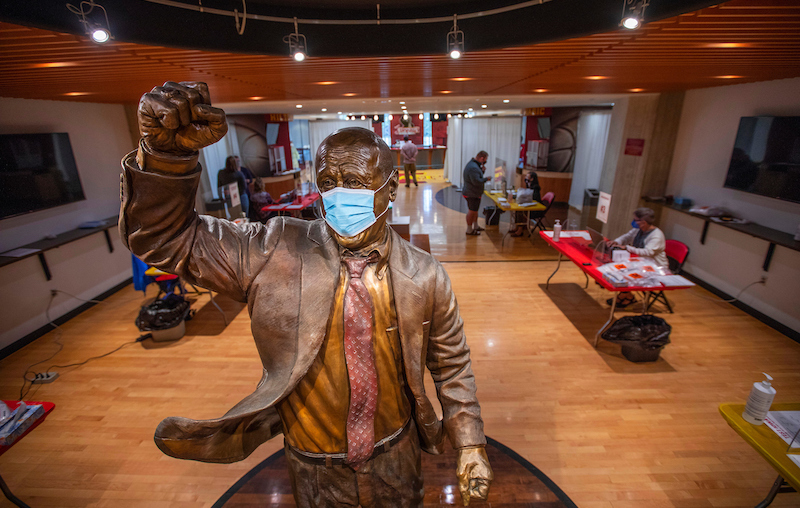
A bronze statue of former men's basketball coach Johnny Orr welcomes visitors to the registration area of the university's new COVID-19 testing clinic inside Hilton Coliseum. Photos by Christopher Gannon.
This week, the university's primary COVID-19 testing site for students, faculty and staff moved to Johnny’s lounge on the east side of Hilton Coliseum. In addition to expanding testing capacity -- with six registration tables and eight semiprivate testing stations -- the location also provides indoor comfort as the weather changes. Testing this summer at Thielen Student Health Center was in mobile units set up in the north parking lot.
Most ISU patients will have their test done at Johnny's. The exception is student patients at Thielen for whom testing is deemed necessary during an appointment.
Testing hours
- Monday-Friday, 10 a.m.-6 p.m.
- Saturday, 8 a.m.-noon
- Location: Johnny's, Hilton Coliseum
Before you go
Face coverings and appointments are required. Call 515-294-5801 (select option 9) or go to cyclonehealth.org/appt to schedule an appointment. A screening questionnaire needs to be completed prior to arriving at an appointment.
Those being tested should bring their ISUCard and email confirmation that they completed the questionnaire. Greeters will ask to see these at the doors.
Getting there
Those being tested should park on the east side of Hilton Coliseum; no parking passes are needed.
Individuals who are symptomatic should not use CyRide to travel to the testing site. But, for those who do arrive by bus, CyRide's Orange and Plum routes have added drop-off only stops: the south side of Stephens Auditorium on the Orange route and along University Boulevard on the southbound Plum route. Both are by request; these are not scheduled stops.
The Hilton testing site is available only to Iowa State students, faculty and staff. Others in the Ames community may use local health care providers or Test Iowa, which is operating a testing site in the research park three days a week (12:30-7:30 p.m. Monday, Wednesday, Friday).
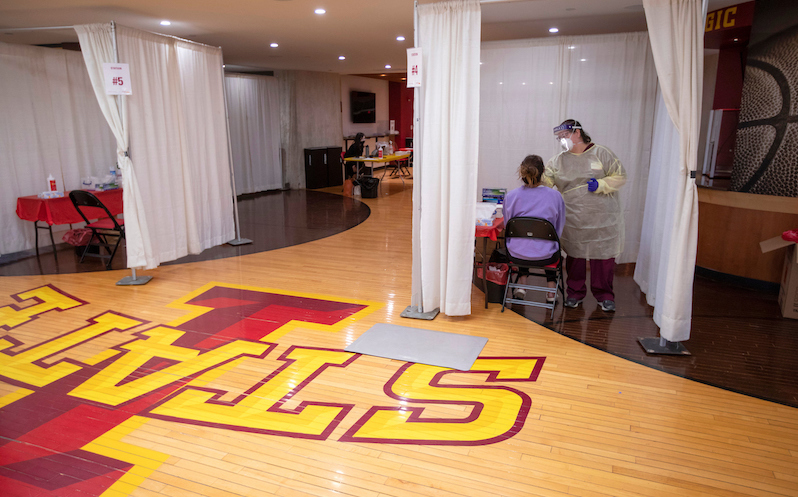
The testing clinic inside Johnny's at Hilton Coliseum has space for eight testing stations.
Expanded Wi-Fi a signal for students to come outside
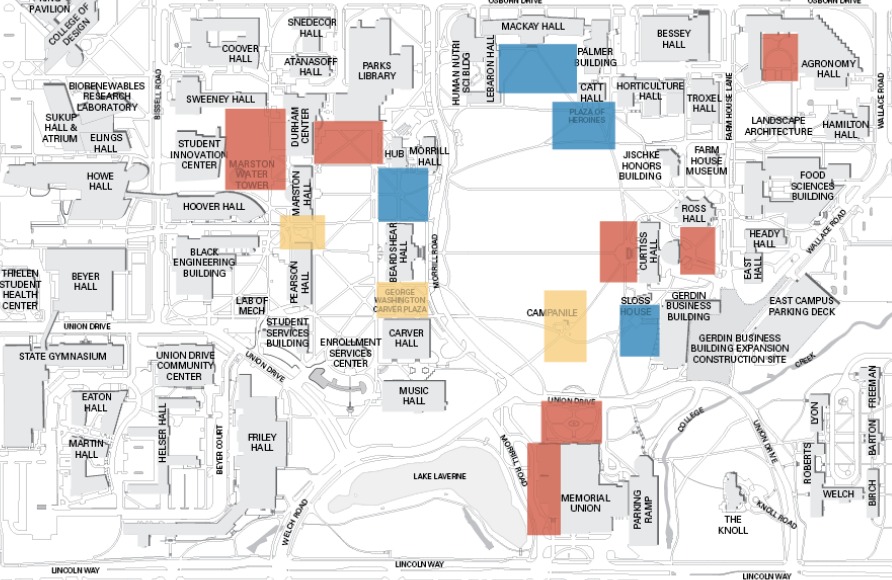
A map of central campus shows areas where Wi-Fi is being expanded outdoors.
To encourage students to use outdoor space, thinning indoor crowds that are a coronavirus transmission risk, information technology services (ITS) is extending Wi-Fi service outside in more than a dozen campus locations.
The expansion was proposed during fall planning this summer as a way to take pressure off indoor gathering spots where students access wireless internet.
"We were thinking specifically of the library and the Memorial Union, where students congregate inside especially around lunchtime," said Kori Spengler, manager of the ITS communication and collaboration team.
Where to connect
Areas north and west of the MU and south of Parks Library were among the first Wi-Fi zones added in an initial phase in early August that also included the Agronomy Hall courtyard, the plazas east and west of Curtiss Hall and the Marston Water Tower courtyard east of the Student Innovation Center, said Connor Kuehl, manager of the ITS physical infrastructure team.
A second phase underway is adding Wi-Fi south of The Hub, south of MacKay Hall, south of Catt Hall and west of Gerdin Business Building. Later this fall, a third phase will expand service south of Marston Hall, in the George Washington Carver Plaza south of Beardshear Hall and in the area surrounding the campanile.
Facilities planning and management's online campus map includes a filter for identifying outdoor Wi-Fi locations. Tents are being added to some of the same areas to make it more inviting for students to use outdoor space, COVID-19 response team chair Frank Peters said in an Aug. 31 virtual hall. The Eduroam, IASTATE and Guest wireless networks are available.
Watch out for trees
Delivering Wi-Fi outdoors poses some challenges, said Mike Broders, manager of the ITS network engineering team. The wireless access points, the devices that send the Wi-Fi signal, generally need to be within 300 feet of a distribution node to connect by ethernet cable. Longer distances require a fiber optic line with an independent power source.
"It's probably a little bit more involved than most people would expect. There's quite a bit involved just with determining placement and where you're going to get your most bang for the buck," he said.
Trees also are a consideration, Broders said. Foliage is a significant obstacle that will knock out a wireless signal.
"So one of the things that we really had to plan for was making sure these things aren't surrounded by trees. That's one of the beautiful things about campus, the amount of tree cover. But at the same time, for wireless coverage, it's not great," he said.
Tracking traffic
It will take 23 wireless access points to serve the 14 areas. They're built for outdoor use and are resistant to extreme temperatures and moisture, Broders said.
The project doesn't mark the first time Wi-Fi has been available outdoors on campus. There were some outdoor hot spots years ago, but they were phased out as hardware was replaced because they didn't get used much, Broders said.
So far, that's not the case with the new areas. They're getting traffic, though it's hard to determine precisely how much.
"We can see the number of clients associated with the access points, but trying to determine how long they're actually staying there is the challenge. We don't want to count those that are just walking by," Broders said.
Employee flu shot clinic opens Sept. 21
Don't pack away all the short sleeve shirts just yet. You'll need one for the employee flu vaccine clinic, which starts earlier and at a new campus location this fall. The ISU WellBeing and occupational medicine programs are sponsoring the clinic weekdays Sept. 21-Oct. 2 in the Stephens Auditorium north lobby. Parking is available in Lot F between the building and Beach Avenue. CyRide's Orange circulator route connects central campus to the center.
The clinic is open 10 a.m. to 4 p.m. for all eligible employees. Older employees or those at higher risk due to medical conditions may receive their vaccination during the 9-10 a.m. hour. Appointments aren't needed for either group. Adventure 2 participants are invited to check the new "My Updates" portal for current information on wait times (if any) at the clinic.
Learn more
The vaccination at the employee clinic will be administered via injection. It contains four components that protect against two A and two B flu virus strains. Both flu mist and higher dose (targeting those 65 years and older) options exist this season, but neither will be available at this clinic.
The federal Centers for Disease Control and Prevention recommends flu vaccines during the pandemic, including in communities where COVID-19 is spreading.
Come prepared
To ensure everyone's safety and health, the Cyclones Care behaviors will be enforced at the flu clinic, including face coverings, physical distancing, designated entrance and exit doors and hand sanitizer availability. Employees who aren't feeling well should stay home. Those attending the clinic are asked to wear short-sleeve or loose-fitting clothing. Additionally, they will:
- Answer the Cyclones Care daily symptom checker.
- Have their temperature checked. Any employee with a temperature of 100.4 or greater will not be able get a vaccine that day.
- Need to know their nine-digit employee number at registration.
Who's eligible?
These university employees may receive a flu vaccine at no cost:
- Faculty, professional and scientific and merit staff
- Postdoctoral scholars
- University Child Care employees
- ISU Foundation employees
- Iowa State Daily employees
- ISU retirees on an ISU health plan who are not yet 65
Employees' spouses and children are not eligible for vaccinations at this clinic. Visiting scholars and students -- both graduate and undergraduate -- should use the Thielen Student Health Center for their annual flu vaccines.
Meet Carol Faber, Faculty Senate president
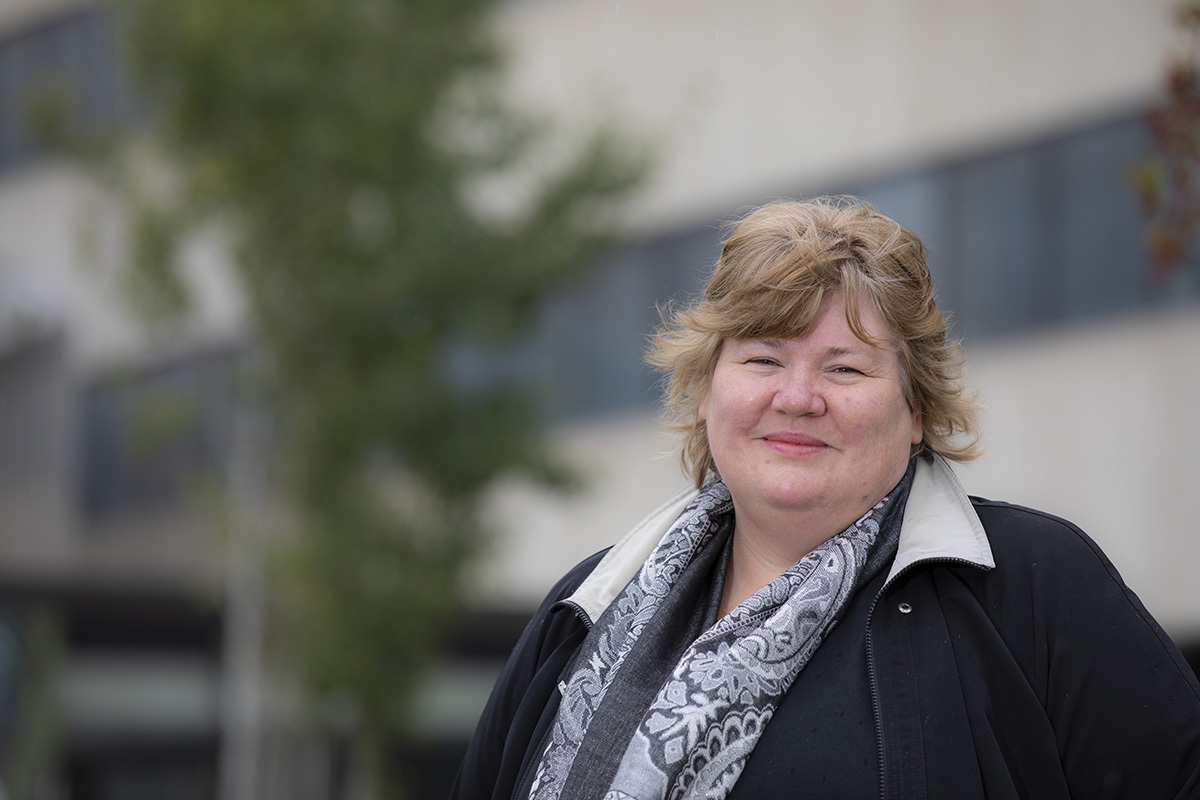
Faculty Senate president Carol Faber. Photo by Christopher Gannon.
Position: Associate professor of graphic design
Years at ISU: 15
Contact: 294-4703, chfaber@iastate.edu
What are the priorities for your presidency?
To get through a difficult year with COVID-19 is the first priority. Faculty Senate still needs to do business as usual, and the priority is to get everyone's agendas completed as best we can. I don't see senate as my agenda. It is a team with all of us working together.
What challenges do faculty members face this year?
It is the fear of the unknown because we don't know how this virus is affecting each of us, and it is still a learning curve. Many faculty worked incredibly hard over the summer to catch up and get their classes where they wanted them to be, and all of us -- myself included -- have had to learn how to teach differently and in different modalities. We haven't had that normal summer, so there is a lot of tension because we are isolated from each other. The interaction isn't the same, and there is some struggle with this abnormal time in our lives.
What should senate do to help lead in the university’s pandemic response?
Senate is a cross section of every department and college, so it is up to us to listen and be that communication structure that voices what is working and what is not. The (Faculty Senate) executive board was meeting over the summer to react to all the changes in policy in shared governance with the provost. All of the memos he has put out have been endorsed by senate. Those communications have been vetted through the executive board to have input and give faculty a voice.
How would you define a successful year for the senate?
We need to get through the business we would conduct in a normal year, plus help faculty while being good citizens of the university as far as COVID-19. That also means helping the students be successful.
Tell us something about yourself that may surprise your colleagues.
My father died and my mother worked as a nurse, so at a very young age I helped run our Iowa farm with my sisters. That experience is a big part of who I am. It grounds me, and I am pretty practical in the way I go about things. That experience connects me to the greater mission of Iowa State.
Meet Sara Parris, P&S Council president
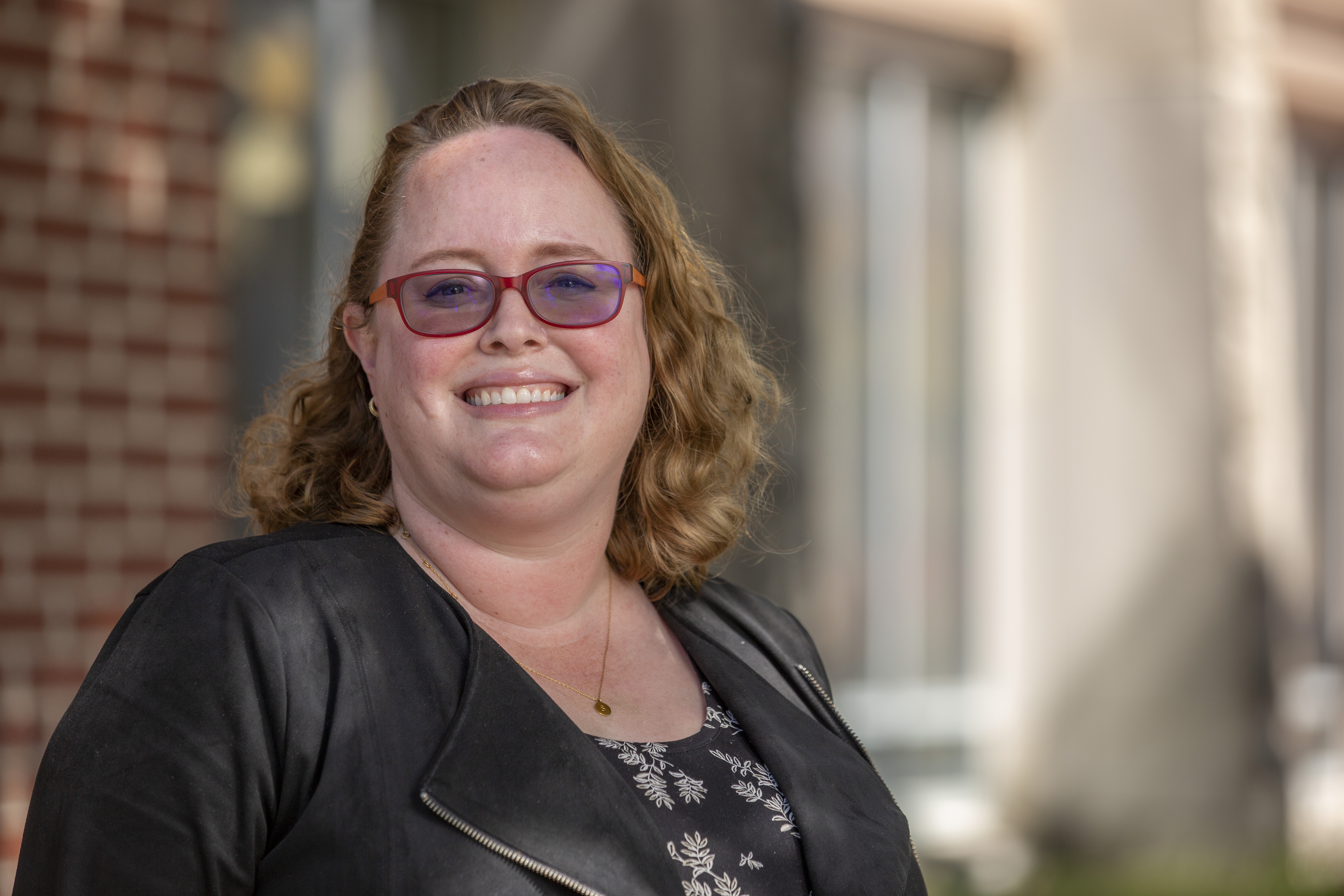
Professional and Scientific Council president Sara Parris. Photo by Christopher Gannon.
Position: Associate director, Thielen Student Health Center
Years at ISU: 5
Contact: 294-5742, sparris@iastate.edu
What are the priorities for your presidency?
With everything going on in the world, we really wanted to drill in on a few key priorities. So we have four key priorities for this year. One I'd specifically like to call out is continuing to advocate for supervisor training, which is something I'm really passionate about. This year we've decided to be a little more targeted in our approach. We're requesting the development and implementation of a training program that focuses on the fundamentals of being a supervisor at Iowa State. What does a supervisor need to find in Workday? Where can they find relevant policies and procedures that will help them manage their employees? Are there forms they need to know how to locate and use? Things like that. I'm hoping this focus feels more manageable to leadership, and that it can serve as a foundation for a more robust supervisor training program in the future.
What challenges do professional and scientific staff face this year?
What challenges aren't we facing right now? I think we're all dealing with a great deal of uncertainty because of the pandemic. Staff are trying to figure out how to balance their work with online school for their kids. They're stressed, and they need mental health support. They really need the university to support flexible work arrangements. COVID-19 also has had a catastrophic impact on our already dismal budget, and that is leaving many staff anxious. Council's goal is to make sure we're at the table with senior leadership during those tough budget conversations and to advocate for temporary cost-reducing measures that are both meaningful in how they impact the bottom line and in the best interest of P&S staff.
What should council do to help lead in the university's pandemic response?
We really need to be there as a resource for P&S staff. There's a lot of support across campus, but not everyone knows how to access those resources. If we can help people feel like someone on campus cares about them and be that go-between to get support -- whether that is helping them talk to their supervisor about flexible work arrangements or making them aware of available mental health resources -- that's probably the most important thing we can do.
How would you define a successful year for council?
Survival. I think this year it will be important for us to be there for staff and help guide them through things. Also, to not only have a seat at the table when university leadership is discussing COVID strategy or financial strategy but have a voice in the process and be able to advocate for what's in the best interest of P&S staff.
Tell us something about yourself that would surprise your colleagues.
My undergrad is actually in international studies, and I took college-level German in college. I also studied abroad in the Czech Republic and can speak some Czech.
Cyclones share their silver linings
As we begin our seventh month as a university community operating in a global pandemic, Inside asked faculty and staff to share light-hearted moments from their lives that help them make the best of a less-than-best situation. Here are a few of the Cyclone silver linings we received from readers.
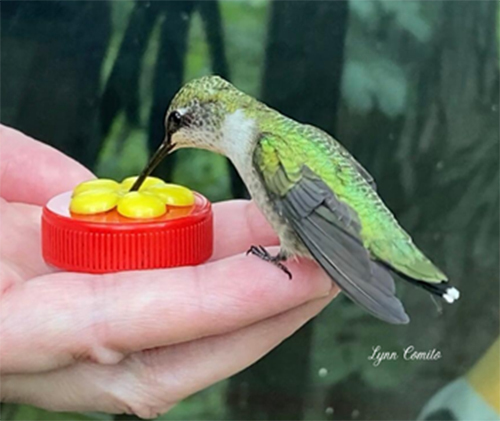
Submitted image.
Lynn Comito, who serves as conflict of interest and commitment administrator in the office of research ethics, also is a bird enthusiast.
"Seeing ruby-throated hummingbirds at our feeders and hearing their cheerful chatter brightens my days," she wrote. "I recently sat outside with a hand-held feeder, and hummingbirds perched on my hand to feed, a first for me and a highlight of my summer."
Jessica Bell, project manager in the Grants Hub, wrote about several daily bright spots.
"It’s been a joy to be able to have lunch with my husband, something that was not possible pre-COVID. Eating lunch on our deck has provided us the opportunity to enjoy some fresh air and sunshine," she wrote. "Finally, my feline co-worker demands personal attention now and then, reminding me to take a break from the screen!"
Bob Currie, director of facilities services in facilities planning and management, said he emails memes or some form of encouragement every Wednesday and Friday to the members of his management and operations teams. He credits his wife, College of Liberal Arts and Sciences fiscal officer Venita Currie, with starting the practice and sharing items with him.
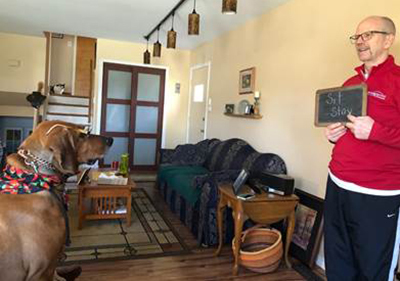
Submitted image.
Kathy Parsons, associate professor and head of the preservation and stacks management department in the library, said the pandemic has strengthened a long-distance sibling relationship. Parsons wrote that she and her Chicago-area brother (also an educator) exchange short texts with a photo of something funny or interesting.
"Since the first exchange (pictured right, which her brother captioned "Teaching Old School"), we have rarely gone more than a few days without sharing photos and messages about trees, flowers, birds, animals, buildings and other unique things we spot."
Parsons said they also started a weekly video meetup for various card, dice and board games.
"Most of the time we play online, but sometimes we are playing with the same physical game mirroring what is happening 360 miles away," she wrote. "I hope these exchanges and meet-ups will be part of our post-pandemic norms."
Stacy Joiner, partnership specialist for the Critical Metals Institute at Ames Laboratory, wrote that she, Susan Elsner and Cynthia Feller, who are 25-year friends because of their jobs on campus, took part in the ISU Alumni Association's virtual craft event Aug. 20. The three friends were able to get together, socially distance and relax while completing craft kits they picked up in advance.
Not incidentally, Joiner's email signature ends with "Be Safe. Be Well. Be Positive. Be Hopeful."
New faculty try to find footing amid pandemic
Whether they are a first-time faculty member or a veteran educator new to Iowa State, the pandemic has added an extra wrinkle for new instructors trying to find their footing.
Meeting fellow faculty, teaching and finding a successful work-life balance have been altered. It may not be how they thought their first semester would go when they applied for the position, but new faculty are dealing with successes and challenges every day.
Settling in
Katherine Madson, an assistant professor in civil, construction and environmental engineering, began her first faculty appointment at home July 1. The pandemic kept her from familiarizing with campus or meeting many members of her department after moving from Florida.
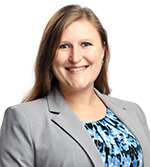
Katherine Madson
"I didn't know what went into preparing a class," she said. "If people had been around, I think it would have been a more organic conversation."
Simple cues like being able to hear students or read their facial expressions are more difficult with a mask. They were not challenges Madson had anticipated as she prepared for the classroom setting.
She leaned on faculty she met during online meetings in May and started pulling together information to apply for a grant.
"The people I met three months earlier are the only reason I knew I should be doing this or that," said Madson, who has a pair of mentors to help guide her.
Teaching assistants provided a walking tour of campus, but her experience lacked the comradery that comes with a typically buzzing campus, Madson said.
"You move to a new town, and it is hard to meet new people at this time because there aren't any activities going on -- and the ones that are, happen online," she said.
"I came in as new faculty during a pandemic, but every new faculty has challenges. I don't know that mine are any more or any less than anyone else coming in, just different."
Preparation is key
Todd Kingston, assistant professor in mechanical engineering, began his appointment with Iowa State Aug. 16 and was teaching his first class as a faculty member -- an online lecture -- at 7:45 a.m. the next day. Fortunately, Kingston earned bachelor's and master's degrees at Iowa State, which gave him some familiarity with the university.
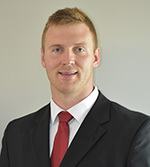
Todd Kingston
Teaching assignments and delivery format were decided in advance of Kingston's arrival, giving him time to prepare mentally and develop the course materials. He teaches a 400-level course that includes a lab and lecture, and began ordering equipment needed to synchronously deliver his lectures online before his start date.
"My expectations were a little different than they would have been had the pandemic not happened," said Kingston, who delivers his online lectures from his office. "Campus and classes look different."
He is able to lean on other instructors and participates in a weekly virtual meeting with the course's teaching team.
Kingston took advantage of many offerings from the Center for Excellence in Learning and Teaching to familiarize himself with new technologies while also utilizing online training.
He brings enthusiasm to teaching at his alma mater, but the pandemic forced changes that test him.
"I miss the face-to-face interactions and the excitement and energy you get in the classroom," Kingston said.
Little things make a difference
Anne Farniok, assistant teaching professor of interior design, taught at a technical school in Minnesota for 12 years before spending last year at the University of Northern Iowa. She is teaching a pair of hybrid studio classes that meet both in-person and online.
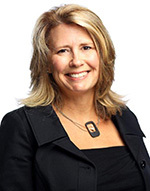
Anne Farniok
Farniok came to campus with experience, but it is the separation from fellow faculty that is most challenging, even for a veteran educator.
"Typically, starting a new job, you would have someone in an office that is next to you or there with you pretty consistently," she said. "You don't have that. You might send an email or reach out, but it is just not the same. It feels like more of a hurdle to get your questions answered."
The College of Design is set up to have co-instructors for studio courses, which benefits Farniok. Having other instructors already established in the classes has been helpful, she said. She continues to adjust to Canvas and its setup, having previously worked in Blackboard.
Before fall classes began, Farniok got to know some faculty members while helping to paint and clean their shared office space. The limited interaction had a lasting impact.
"We still group-text each other, and I guess I would say I have a closer bond with them because of it," she said.
Reducing, reusing are keys to limiting COVID-19 waste surge
Thanks in large part to paper towels and sanitizer wipes -- common supplies for employees charged with cleaning their own work areas -- mitigating the risk of the coronavirus is bound to increase the amount of campus garbage.
Zero-waste opportunities
Interested in a virtual departmental presentation on Iowa State's zero-waste initiative or connecting students with opportunities to contribute to the effort? Contact Ayodeji Oluwalana at recycling@iastate.edu.
That's why it's more important than ever to be thoughtful about generating as little trash as possible, said Ayodeji Oluwalana, recycling and special events coordinator for facilities planning and management (FPM). From the refrain of "reduce, reuse and recycle," reusing and reducing have taken on even bigger roles than usual, since disposable single-use items expected to drive surges in waste aren't recyclable.
"People should carefully consider what waste they're generating in the first place," said Oluwalana, who launched a zero-waste effort in 2018 aimed at diverting 85% of ISU refuse from landfills by 2025. "While we're managing a health crisis, we don't want to create other problems down the road."
That starts with only buying what's needed, he said. Even purchases of durable goods tend to create immediate waste -- think of the packaging tossed out when an office replaces its computers, for instance. Plus, raising the bar for buying brings savings to help manage shrinking budgets.
"It's a good time to ask if you really need what you're trying to acquire now," he said.
Departments that do need to make large purchases can include waste reduction provisions in contracts, requiring vendors to limit or manage waste, Oluwalana said.
At an individual level, reusable items remain safe when washed regularly and not shared with others, despite the increased reliance on disposable products during the pandemic, Oluwalana said. Like wearing a cloth face covering instead of a throwaway surgical mask, using washable plates and silverware for lunch at the office or a personal towel for drying your hands in the bathroom is safe and an effective way to slash trash production.
For daily sanitizing at a workstation, consider bringing a clean rag from home every day instead of burning through paper towels and sanitizer wipes. If a disposable method seems necessary, Oluwalana suggested opting for paper towels and cleaning spray over sanitizer wipes because most wipes are not biodegradable and are permanent scourges in landfills.
Because of the added work of sanitizing classrooms, restrooms and other common areas during the COVID-19 crisis, FPM custodial teams aren't cleaning offices and conference rooms this school year. In addition to cleaning their own work spaces, employees must take their own recycling and trash to central bins. That requirement may make it easier to expand a pilot project Oluwalana began last year in FPM's General Services Building to remove garbage cans from desks, which boosted recycling rates by making it more convenient than throwing something in the trash.
Oluwalana had planned to extend the recycling-only initiative to a handful of academic buildings last spring, but it was derailed by the reduced operations caused by COVID-19. He will be recruiting building managers this fall to restart the project.
"It's all about trying to change behavior," he said.
Semi-annual Workday upgrade occurs this weekend
As part of Workday's twice-yearly update schedule, a bundle of software updates will be available to the Iowa State community after 9 a.m. Saturday, Sept. 12.
While Workday provides minor fixes and security updates on a weekly basis, these biannual releases are larger in scope and improve the function and/or user experience with the software. In preparation for the release, Iowa State WorkCyte teams have been previewing and testing features to ensure the upgrades perform as expected.
What's new?
Most are systemwide and improve function on both sides -- finance/planning and human capital management -- for Iowa State users. These include a more helpful search/prompt function in the search bar and a feature called "My Shortcuts," which lets the user create shortcuts to often-used tasks and reports. The process of exporting reports to Excel also has been improved, correcting some difficulties with large file downloads and providing a consistent process across various browsers.
On the HR side, the updates include a new option, "Frequently Used Related Actions," which displays up to five often-used tasks. And on the finance side, Workday reduced the time and effort it takes to create, edit and submit expense reports, and now provides a more consistent user experience across desktop, Android, iPad and iPhone devices.
The newest set of improvements is titled Workday 2020 Release 2 (2020R2 for short). Users can read more about each improvement in a new IT Services Knowledge Base article.
Service interruption on Saturday
Access to Workday will be interrupted for approximately eight hours (1-9 a.m. CDT on Sept. 12) while the upgrade is implemented. Managers and timekeepers should inform employees checking in or out for work this day of the change and make updates as needed when the system is available again. This will not affect workers using time clock devices.
This power plant tour is a little quieter
This is the time of year Iowa State's utilities staff sees its first uptick in requests for power plant tours. Assistant director for utility plant operations Lindsey Wanderscheid estimates up to 800 students -- engineering, environmental studies, design, economics and more -- tour the main plant each year for a class or student organization activity.
It's part of the utilities staff's outreach to the campus community, but because in-person tours are on hold this semester, the staff, led by engineer Jon Fleming, instead created two virtual options that feature slides and video with voiced commentary. The first, about 50 minutes long, is a presentation that covers topics such as:
- What the university's utility system does, including the concept of cogeneration
- Campus buildings' energy use and how it has changed over the years
- Fuels burned on campus
- Power plant emissions
- Renewable energy
- Energy costs
In just 35 minutes, the second option tours three of the university's four utility production facilities: main power plant, north chilled water plant and the plant at the College of Veterinary Medicine campus. Wanderscheid said the fourth plant, at the Applied Sciences Complex, has similar equipment to the Vet Med facility and was excluded for brevity.
The presentations are filed in CyBox; faculty and staff who want to share one or both with campus audiences should contact Wanderscheid, lwander@iastate.edu, for the link information.
